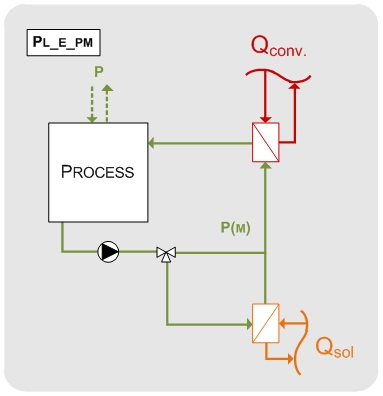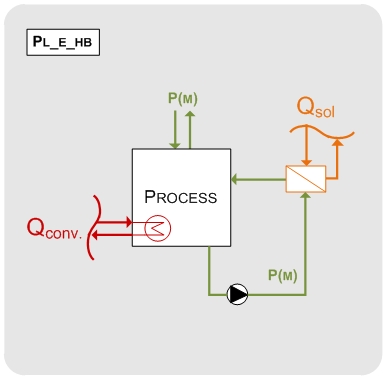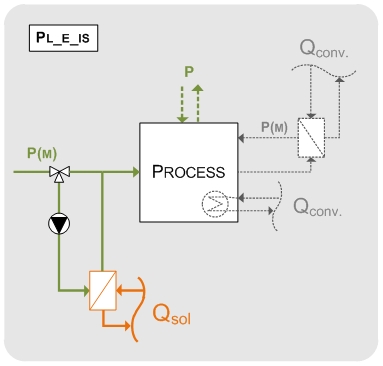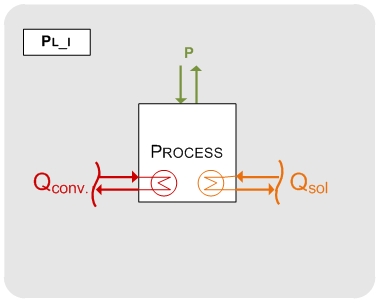|
|
| Line 14: |
Line 14: |
| | |[[File:PL_E_IS.jpg]] | | |[[File:PL_E_IS.jpg]] |
| | |'''PL_E_IS - external HEX for heating of input streams''' | | |'''PL_E_IS - external HEX for heating of input streams''' |
| | + | |
| | The fourth possibility for integration of external heat exchangers is solar heating of input streams. Lots of processes require continuous or batch feed-in of product or process media streams. E.g. feed-in of fresh water for compensation of evaporation losses or fresh air for drying applications. Based on the specific process it can be reasonable to preheat these input streams. The dashed lines within the process flow sheet indicate possibilities for the conventional heating of the existing process. Possibly, this integration concept can be combined with PL_E_PM and PL_E_HB. | | The fourth possibility for integration of external heat exchangers is solar heating of input streams. Lots of processes require continuous or batch feed-in of product or process media streams. E.g. feed-in of fresh water for compensation of evaporation losses or fresh air for drying applications. Based on the specific process it can be reasonable to preheat these input streams. The dashed lines within the process flow sheet indicate possibilities for the conventional heating of the existing process. Possibly, this integration concept can be combined with PL_E_PM and PL_E_HB. |
| | + | |- |
| | + | |[[File:PL_I.jpg]] |
| | + | |'''PL_I- Process level with internal heat exchanger''' |
| | + | |
| | + | The integration of an additional heat exchanger surface within baths, machineries, or tanks is used for the category “heating and maintaining temperature of baths, machineries, or tanks”. Usually, the additional solar driven internal heating surface is installed in parallel to the conventional heat source. For this concept it is important to consider the available space in the process equipment since it is usually limited due to the treated product (e.g. metal parts) or components (e.g. stirrers, strainers, etc.). |
| Different process technologies exist within industry, which lead to several possibilities for the integration of solar heat. Based on the general classification of industrial heat consumers cleaning processes are assigned either to the category “(pre)heating of fluid streams” or “heating and maintaining temperature of baths, machineries or tanks”. By consideration of the conventional heat supply, different integration concepts are possible.
|

|
PL_E_PM - external HEX for heating of product or process medium
This integration concept is basically the easiest since an additional solar driven heat exchanger is installed in serial to the conventional heat exchanger to heat a product or process medium (e.g. water, lye, fruit juice, etc.). It can be applied to all three categories of heat consumers “(pre)heating of fluid streams”, “heating and maintaining temperature of baths, machineries or tanks” and “thermal separation processes”. The serial integration of a solar driven heat exchanger can be realized in a way that only part of the entire product or process medium stream is heated up and hence heat exchanger surface, pump and pipe dimensions can be kept small.
|

|
PL_E_HB - external HEX for heating of bath, machinery, or tank
This integration concept is used to heat baths, machineries, or tanks via an additional external heat exchanger. Therefore, the product or process medium is drawn from the bath, machinery, or tank, heated by solar energy and fed back. It’s crucial for this integration concept to identify a suitable position or point in time within the process where the temperature of the product or process medium is relatively low. Else this concept would lead to a parallel integration of solar heat to the conventional heat supply. If the product or process medium must be kept in a very narrow temperature range (due to operational issues), the resulting temperature difference for solar heating might be very small.
|

|
PL_E_IS - external HEX for heating of input streams
The fourth possibility for integration of external heat exchangers is solar heating of input streams. Lots of processes require continuous or batch feed-in of product or process media streams. E.g. feed-in of fresh water for compensation of evaporation losses or fresh air for drying applications. Based on the specific process it can be reasonable to preheat these input streams. The dashed lines within the process flow sheet indicate possibilities for the conventional heating of the existing process. Possibly, this integration concept can be combined with PL_E_PM and PL_E_HB.
|

|
PL_I- Process level with internal heat exchanger
The integration of an additional heat exchanger surface within baths, machineries, or tanks is used for the category “heating and maintaining temperature of baths, machineries, or tanks”. Usually, the additional solar driven internal heating surface is installed in parallel to the conventional heat source. For this concept it is important to consider the available space in the process equipment since it is usually limited due to the treated product (e.g. metal parts) or components (e.g. stirrers, strainers, etc.).
|



